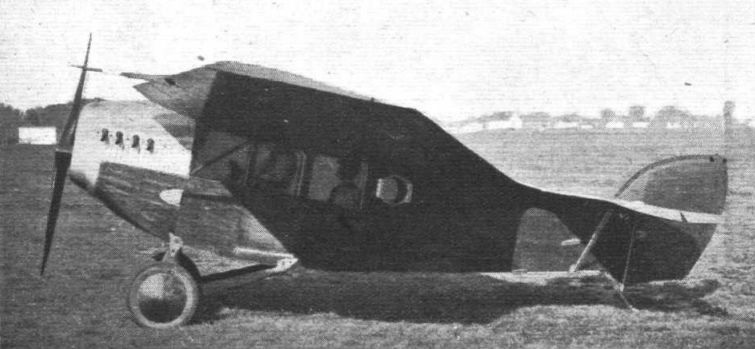
Flight, December 1920
THE STOUT "BAT-WING" MONOPLANE
TEST flights were recently carried out at Detroit with a commercial model Stout "Bat-Wing" monoplane, and although this machine is designed on more or less unconventional lines, embodying new principles, it took off, with but a preliminary 50-ft. run, at once for a 20-minute cross-country flight on its first trial. It was piloted by the well-known American mail pilot, Bert Acosta, who claimed for this machine, after the trial flight, that it was a decided advance over anything he had ever before piloted. After the first lap around the field he found the 'bus was sufficiently stable to enable him to fly for minutes at a time with his hands and feet completely off the controls.
This machine is the design of William B. Stout, and was built by the Stout Engineering Laboratories at Detroit, where experimental work on machines of this type has been carried on since the end of the War. It is a cantilever monoplane with thick tapering wings, mounted above the limousine body. The principal characteristic of the "Bat-Wing" is that the chord of the wing increases considerably from tip to root - in fact, at the root the chord of the wing is very nearly equal to the length of the machine itself. Veneer, or ply-wood, construction is employed throughout the machine, including the wings, which are internally trussed and completely covered with veneer.
The engine, one of the new 200 h.p. Packard, is mounted in the nose of the fuselage, driving a tractor screw, in the usual way. Immediately behind is the cabin, accommodating pilot and two passengers. The pilot is located in front, and the passengers behind. Large windows are provided in the sides of the cabin, whilst a large window of non-breakable glass, immediately above the pilot, gives the latter a clear view of the air above.
The petrol tanks are located within the wings, well away from the engine, and the air intake for the carburettor is carried completely outside the body, thus reducing the risk of fire to a minimum. The radiator is fitted with shutters for high altitude work and operated from the pilot's seat. To minimise shocks, the landing gear has been fitted with oversized wheels and tyres. The cabin itself is luxuriously furnished, having been laid out with the idea of maximum comfort for the pilot and passengers. With the engine running at high speed there is no more noise in the cabin than in an enclosed motor-car, and conversation may be carried on with ease. To the rear of the cabin is a special baggage compartment. All wing fittings and control rods axe especially treated and absolutely rustproof.
The Stout "Bat-Wing" Limousine weighs 1,820 lbs., and its maximum speed is said to be well over 125 m.p.h., whilst the landing speed is but 45 m.p.h. We understand that the U.S. Navy has placed an order for six torpedo 'planes of the "Bat-Wing" type of all-metal construction with this firm.
- Flight, December 1920
THE STOUT "BAT-WING" MONOPLANE
Фотографии
-
Flight 1920-12 / Flight
The Stout "Bat-Wing" Limousine Monoplane: An American machine of somewhat unusual design. The cantilever wings, which are of veneer construction throughout, have an exceptionally large chord at the roots
- Фотографии
